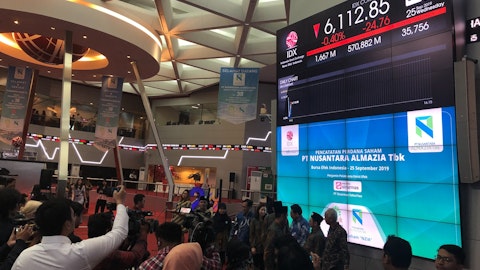The other part of the investment would be the trucks. But we rent most of the trucks, so it’s a rather kind of like less book on the CapEx for this.
Yanjun Wang : Also to clarify, the model of logistics that we have is not, at this point, a CapEx-heavy model. We’re not looking to build mega warehouses or mega machinery type of logistics in that model. Our model is more about building a large network of small sorting centers, small hubs into many, many neighborhoods, and also build a team capability to expand our last mile coverage across a wider network of areas covered by us. So it’s more OpEx. And for the past few years, we have already been consistently investing in logistics, which is one of the key reasons that has got us to the current position of continue to reduce the logistic shipping fees and also a key competitive advantage that we have.
Forrest Li: Just want to add on this a little bit. Actually, compared to many other logistic providers, if you look at the three regions, our CapEx has been a lot lower if you compare. And there’s a reason for that, actually, because we are able to predict our volume in a lot more accurate ways. Imagine if you are a third party logistics, you have to forecast what your volume be in the next year or next two to three years in order to invest in CapEx. It’s extremely hard, especially in our market. For our own logistics, we have a good way, let’s say, to predict what’s the demand in our market, not only for next month, not for next quarter, but in the next two to three years, most likely. As a consequence of that, we are able to CapEx things, not only CapEx actually.
Take on the designing of our networks, as Yanjun mentioned, to design our network in a very flexible way, to design our network in a very optimized way. After design network in a good way, then you can manage your CapEx in a much more efficient way. And every CapEx can be put to use right after you capitalize on it. Rather than sometimes you have to rush for it or you have to capitalize on things, you build something but you win to be used. I think in this aspect, we have a good advantage compared to the other offerings in the market. That’s also why we can manage our cost down compared to the other offerings.
Yanjun Wang : Regarding the question on ROFR agreement with Tencent, it is automatically renewed every year unless terminated by either party. The agreement is also publicly available.
Operator: Our next question comes from Jiong Shao from Barclays. Your line is now open.
Jiong Shao: Great. Thank you for taking my questions. I have two questions and a follow-up. The first question is that since you pivoted for growth a few months back, it’s great to see the GMV now is growing year-over-year. I was wondering, could you talk about the linearity as you went through the quarter? I suspect the momentum picked up during the quarter. And could you talk about sort of, so far in Q4, how that GMV growth momentum has been? That’s — any comment on FX impact, that would be great. Second question is, I think you talked about live streaming, obviously, the key focus for growth. You mentioned 10% GMV. I wasn’t sure, is that for Indonesia? Or is that for the whole region? My question is about your long-term expectation.
As you know, in countries like China, live streaming is called 20%, 25% of total GMV. For the industry, what do you think that number could be or should be for Southeast Asia, I don’t know, in a few years, and where you are currently for the region? And related to that, since the TikTok sort of shut down in Indonesia, what have you seen, if anything, the impact for your growth for your market share? And lastly, for the follow-up I had is that you mentioned a couple of times that you committed to investing within our means and will not raise any financing going forward. And in Q3, you did a great job. You grew your GMV, grew your revenue while making some profits for the group. I was wondering, is that sort of a breakeven or small profit is sort of the guardrail you meant by investing within your means?
Thank you.
Tony Hou: Let me start first. In terms of the growth over the quarter, I think the — we don’t have a detailed month-to-month break number shares. But in general, if you look at the year-to-year growth, we do see a better year-to-year growth over the months. That for Q4, we do see the trend continues. So, so far, as we are right now, we see the broadly similar trend in terms of the growth levels floating from Q3 to Q4. And the impact on Forex, generally, I think the number we shared is in the U.S. terms. But if you take the constant currencies, we actually grow better. In quite many of markets actually, there is a depreciation against U.S. dollar. So operationally, if we take the constant currency, we grew better than the U.S. dollar basis.





